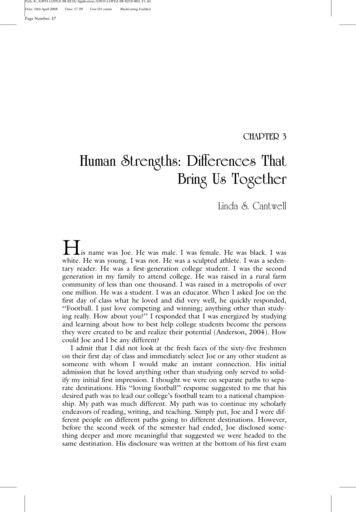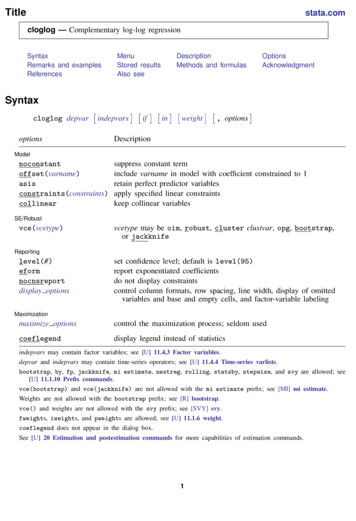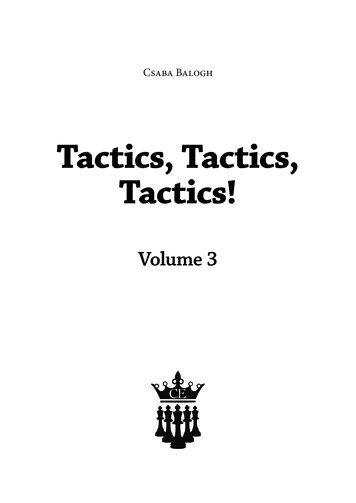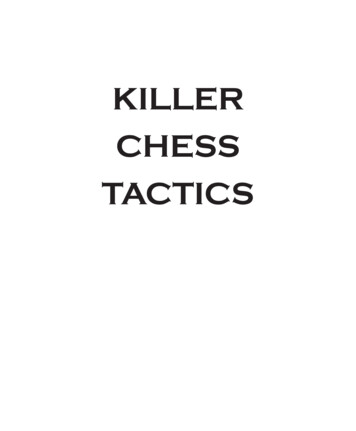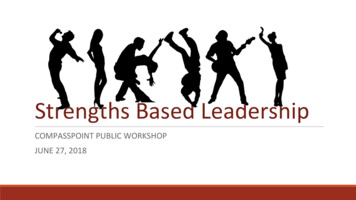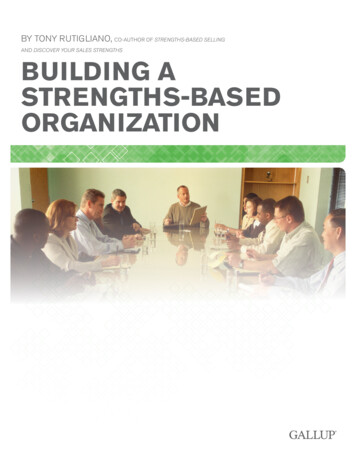
Transcription
Complementary Strengths: Western Psychology & Traditional HealingRebuilding hope for child soldiers in post-war Mozambiqueby Lucrecia Wambaedited by Liam MahonyA Tactical Notebook published bythe New Tactics Projectof the Center for Victims of Torture
Published byThe Center for Victims of TortureNew Tactics in Human Rights Project717 East River RoadMinneapolis, MN 55455 USAwww.cvt.org, www.newtactics.orgNotebook Series EditorLiam MahonyDesign and CopyeditingSusan EversonThe Leadership Academy of the Desmond Tutu Peace Centre and the Center for Victims of Torture wish toacknowledge the following institutions that provided support for the New Tactics in Human Rights Africanregional training workshop, of which this and other tactical notebooks are a product:·The Rockefeller Foundation·The International Center on Nonviolent Conflict·Norwegian Church Aid·The European Union Conference, Workshop and Cultural Initiatives Fund in conjunction with theSouth African National Trust·The United States Department of State·The United States Institute of Peace·Donors who wish to remain anonymous.We are also greatly indebted to the work of numerous interns and volunteers who have contributed theirtime and expertise to the advancement of the project and of human rights.The New Tactics project has also benefited from more than 2000 hours of work from individual volunteersand interns as well as donations of in-kind support. Some of the institutional sponsors of this work includeMacalester College, the University of Minnesota, the Higher Education Consortium for Urban Affairs, theMinnesota Justice Foundation and the public relations firm of Padilla Speer Beardsley.The opinions, findings and conclusions or recommendations expressed on this site are those of the NewTactics project and do not necessarily reflect the views of our funders For a full list of project sponsors seewww.newtactics.org.The views expressed in this report do not necessarily reflect those of the New Tactics in Human RightsProject. The project does not advocate specific tactics or policies. 2004 Center for Victims of TortureThis publication may be freely reproduced in print and in electronic form as longas this copyright notice appears on all copies.
54Author biographyLetter from the New Tactics project manager6Introduction7Political background8Why the use of children as soldiers8How the tactic works9The development of the tactic12The aims of intervention13The collaborative strategy15The war experience for girls16Outcomes & evaluation17Psychological support & material assistance1717Human rights & traditional practicesApplying the tactic to a different context18ConclusionThe Center for Victims of TortureNew Tactics in Human Rights Project717 East River RoadMinneapolis, MN 55455 USAwww.cvt.org, www.newtactics.org
Lucrecia WambaAcknowledgementsThank you to all our project partners in JosinaMachel Island, and to our funders, without whosesupport and collaboration this work would nothave been possible. Thanks also to RE’s teamand associate members, who always believedthat, even with a huge problem such as that offormer child soldiers, change was possible. Andto Boia Efraime Junior for his support and hisdedication to the cause of former child soldiers.I am grateful to the New Tactics Project and theDesmond Tutu Center for providing such an opportunity to share our experiences; to ShifraJacobson for helping me prepare and presentthis work at the Cape Town workshop; and toour editor, Liam Mahony, for his patience andsupport.Lucrecia Wamba is a 29 year-old Mozambican psychologist,born in Maputo province. She studied psychology and pedagogy at Universidade Pedagogica in Maputo, and has alsostudied psychotraumatology and family therapy in a courseco-organized by Reconstruindo a Esperança (RE, Rebuilding Hope) and Hamburg University (Germany).Lucrecia began to work in RE’s community-based programsin 2000, aiding with a project that provided psychologicalassistance to children affected by floods in the south ofMozambique. By seeing the work done by RE with formerchild soldiers, she soon became interested and involved. Hercommitment has been deeply supported and reinforced byher colleagues, particularly Dr. Boia Junior, a psychologistand founding member of RE who has been involved sincethe beginning with the project to help former child soldiers.Contact InformationAssociacao Reconstruindo a Esperanca385, R/C, Av. Martires da MachavaP.O.Box: 1855Maputo, Mozambiquephone: 258-1-485877fax: 258-1-485876
September 2004Dear Friend,Welcome to the New Tactics in Human Rights Tactical Notebook Series! In each notebook a humanrights practitioner describes an innovative tactic used successfully in advancing human rights. Theauthors are part of the broad and diverse human rights movement, including non-government andgovernment perspectives, educators, law enforcement personnel, truth and reconciliation processes,and women's rights and mental health advocates. They have both adapted and pioneered tactics thathave contributed to human rights in their home countries. In addition, they have utilized tacticsthat, when adapted, can be applied in other countries and situations to address a variety of issues.Each notebook contains detailed information on how the author and his or her organization achievedwhat they did. We want to inspire other human rights practitioners to think tactically-and tobroaden the realm of tactics considered to effectively advance human rights.In this notebook, we learn about efforts to integrate and maximize knowledge from traditional andwestern healing methods to reintegrate child soldiers into communities devastated by war.Rebuilding Hope saw the need for an integrated healing process that would allow families andcommunities to accept child soldiers back into their lives-even those who had killed their relativesand burned down villages. Acknowledging that traditional healers are often the first peoplecommunity members approach when they need help (healing), Rebuilding Hope psychologistsapproached the healers as well as other community leaders, such as teachers and tribal leaders, to beproject partners. The creation of an integrated support system combining western psychology andthe traditional healing processes enabled children to be reintegrated into their families andcommunities as purified people, while the psychologists developed sustainable mental and emotionalsupport systems for them. Such reintegration issues are not unique to Mozambique. Othercommunities dealing with these complex issues of reintegration, whether of child solders or otherpopulations, can find this tactic helpful in generating ideas toward accessing traditional forms ofsupport and healing.The entire series of Tactical Notebooks is available online at www.newtactics.org. Additionalnotebooks are already available and others will continue to be added over time. On our web site youwill also find other tools, including a searchable database of tactics, a discussion forum for humanrights practitioners, and information about our workshops and symposia. To subscribe to the NewTactics newsletter, please send an e-mail to tcornell@cvt.org.The New Tactics in Human Rights Project is an international initiative led by a diverse group oforganizations and practitioners from around the world. The project is coordinated by the Center forVictims of Torture (CVT), and grew out of our experiences as a creator of new tactics and as atreatment center that also advocates for the protection of human rights from a unique position-one ofhealing and of reclaiming civic leadership.We hope that you will find these notebooks informational and thought provoking.Sincerely,Kate KelschNew Tactics Project Manager
IntroductionMental health practices and interventions in developing countries and post-conflict situations are extremelychallenging. A common misperception is that mentalhealth support is the sole task of psychologists, socialworkers, medical doctors, counselors, and nurses—inother words, western-trained personnel. Our experience, however, shows how a community process ofmental health assistance must constructively involveall levels of experience and knowledge in the society.In this tactical notebook, we will describe the reintegration of former child soldiers back into their communities, a process that brought about the collaboration of community leaders, western-trained psychologists, and local curandeiros (healers).All societies and cultures have developed, created, andlearned mechanisms to deal with their specific problems in different spheres of life. If we seek to help acommunity to rebuild itself from trauma, our approachshould first ask “how is this society or community already using its own resources to overcome or dealwith the problem?”traditional disciplines of healing. The process we builtwas as inclusive as possible, facilitating the empowerment of the community as a whole while still caringfor the individual psychological needs of our clients.The project encouraged and depended upon the leadership and support of community religious leaders,local teachers, and parents. With the help of traditional local and religious leaders, we forged links withlocal curandieros. As a result of this collaboration, whenthose under our psychotherapeutic care felt theyneeded traditional purification rituals to wash awaythe bad spirits, we referred them to the curandeiros.Reciprocally, the traditional healers would purify theirpatients and send them to the psychologists for additional support.As a result, an integrated support system was created: through traditional healing processes, childrenwere reintegrated into their families and communities as purified people, while the psychologists developed sustainability methods for mental and emotionalTo illustrate this, I will share with you the experienceof a Mozambican non-governmental organization,Reconstruindo a Esperança (RE, Rebuilding Hope) inworking with children affected by military violence,particularly in rural communities. The work focusedon providing psychological assistance and promotingcommunity reintegration after 16 years of war, in theprocess using and reinforcing community resources.In this notebook we focus on Josina Machel Island, arural community in Maputo province, 130 km fromthe city of Maputo. The island has 10,000 inhabitants,the majority of whom make a living from agriculture,fishing, livestock, and migratory labor (working in theRepublic of South Africa). During the war an important military base was nearby. Many children wereused as combatants, and many were sexually exploited.Collective traumas, like war, are more than the sumof their individual effects. These traumas rip apartthe social fabric, damaging the very foundations ofsocial relations upon which mental health depends.Conventional psychotraumatology tends to focus onthe individual’s experience, but in order to help individuals heal as community members who have lived acollective trauma, something more is needed. The process must involve the community and its indigenoussocial and spiritual support mechanisms. People define their identity in relation to their community andancestors, and after trauma they must rebuild thatidentity with the community. In the cosmology of thatcommunity process, individualized western psychologyalone will not suffice.Rebuilding Hope created a uniquely collaborative process, based on mutual respect for both western and6Post-war community reconstruction of houses, schools, and thelocal hospital.
well-being. The result was a symbiotic model of psychotherapeutic interventions, taking into account thelocal knowledge and culture. During a period of eightyears, Rebuilding Hope has worked with approximately700 children.The lessons we can learn from this go beyond the reintegration of child soldiers. It is our hope that ourexperience will help people working in other contextsto effectively integrate into their approaches the local capacities, cultural concepts, and wisdom, catalytictools that can be essential in rebuilding communitymental health. The need for such cross-cultural integration of healing strategies will certainly be relevantelsewhere, not only in the African context—i.e. Angola,Liberia, Sierra Leone, Burundi, Rwanda, and IvoryCoast—but in other countries as well.Political backgroundMozambique is situated in southern Africa, with 2,800km of coastline facing the Indian Ocean. With an areaof 799,390 km2, its population of 16.9 million is 71.4percent rural. Mozambique has one of the lowestHuman Development Indices in Africa.1 In spite of thepopulation’s largely Bantu origin, the country is multilingual and ethnically diverse, with a diversified mosaic of population origins (Maconde, Swahilis, Macuas,Podzos, Shonas, Senas, Changanes, Bitongas, Tsongas,Rongas, and others).Five centuries of Portuguese colonial domination weremarked by the oppression of the indigenous people,and by economic, social, and cultural inequalities. ThePortuguese despised African culture and socio-political organization. After a nine-year war for liberation,Mozambique became independent in 1975. The ruling government of FRELIMO (Frente Libertação deMozambique) then put a socialist system in place, prioritizing social and agricultural development. Until1981, the country made considerable advances in education and health.The social benefits of independence were cut short,however, by civil war. Not long after independence,those who opposed the newly installed socialist government formed RENAMO (Resistencia Nacional deMoçambique). The ensuing war between FRELIMO andRENAMO was one of the bloodiest in African history.It hindered the country’s development, and its destruction of the economic and social infrastructure forceda great number of people to live as castaways andrefugees.The war was fueled by external regional and geopolitical alliances. The socialist FRELIMO governmenthad close relationships with the communist block, andreceived economic and military support from countries like the USSR, China, and Cuba. Meanwhile,RENAMO was supported by the white-controlled regimes of South Africa and pre-independence Zimbabwe, and by some other countries.The Mozambican conflict cost the lives of almost onemillion people, 45 percent of whom were childrenunder the age of 15 (UNDP, 1990). One and a halfmillion Mozambicans had to seek refuge in Zambia,Zimbabwe, Malawi, Tanzania, and South Africa. Stillanother three million became internally displaced, asrural communities were forced to migrate to urbancenters or locations militarily more secure. At least600,000 children were denied access to school due tothe destruction of 2,655 primary schools, 22 secondary schools, and 36 boarding schools in rural areas.2 Bythe end of the conflict, two million anti-personnelmines were scattered around the country. By 1988,UNICEF estimated that almost 250,000 Mozambicanchildren suffered from psychic and physical traumas.These children had witnessed the deaths of their parents and other family members, had been forcibly displaced from their homes in search of secure shelter,and had been subjected to various forms of abuse,including kidnappings and sexual violence. Countlessfamilies were destroyed or separated.Children were used as soldiers by both sides, often infront-line combat, with adults directing the combatfrom a safe distance. According to UNICEF, some 10,000children were still being used in combat by RENAMO’sguerrilla forces in 1988. An unknown number wereforcibly integrated into the “milicias populares,” localparamilitary forces directed by FRELIMO. Many children were also used as soldiers in the governmentarmy. The data gathered during demobilization efforts at the end of the conflict revealed that 27%(around 25,498) of the demobilized soldiers had beenunder the age of 18 at the time of their recruitment.Of these, 16,553 belonged to the government forcesof FRELIMO and 8,945 to RENAMO.3In the early 1990s, with the civilian population devastated and both warring parties militarily exhausted,FRELIMO and RENAMO negotiated a peace accord,which was signed in 1992. The first democratic elections took place in 1994. The end of hostilities was aboon to the population, but the peace process alsohad many flaws. In particular, neither RENAMO norFRELIMO admitted to having used child soldiers, sochildren were completely left out of the de-mobilization process. Their guns and uniforms were taken, andthey were simply sent back home to fend for themselves.The accumulated impact of the war caused seriouseconomic and social crises. There was no maintenanceof the infrastructure, and farmers often could notmaintain or invest in their land. Productivity decreased,1The National Report on Mozambican Human Development(UNDP, 1999) rated Mozambique with a HDI of 0.341, lastamong African countries. The HDI establishes comparisons relatedto the level of human development among African nations, takinginto account life expectancy at birth, educational level (adult literacyrates and schooling rates), and per capita income in dollars.2Ratilal, Anabela 1989.Complementary Strengths: Western Psychology & Traditional Healing 7
and farming production costs soared, renderingMozambique dependent on foreign aid.In addition to material privations, the conflict took aspiritual and psychological toll on children, their families, and their communities. In a deliberate strategyto de-stabilize FRELIMO’s control over the country andto destroy the fiber of social life and community stability, RENAMO focused its attacks on civilian targetsand infrastructures (Vines, 1991). FRELIMO, in turn,used some of the same strategies to regain controlover contested zones.4 The fabric of the communityso necessary to collective mental health was itself,then, a target and a casualty of the war.Why the use of children as soldiers?According to Boia Efraime Junior, children are considered easier than adults to train, to intimidate, and tocontrol, and less likely to desert. Technological advanceshave also facilitated the use of children. AK-47 machine guns, for example, are light and can be used bychildren as young as eight years old.In Mozambique the children themselves reported varying reasons for their participation. Some were forcedto become soldiers by they own parents or by influential community members, while others were kidnapped. Children who refused to become soldiers wereoften killed as punishment and to intimidate others.How the tactic works:The healing of JonasOur strategy was anchored in the practical and spiritual realities of people’s lives during and after theMozambique civil war. Child soldiers lived through unimaginable horrors, and they processed these experiences through the lens of their community culturesand belief systems. Their healing needed to be processed through the same lens, in order to achieve bothindividual rehabilitation and community reintegration.To illustrate these realities, and to help place the subsequent analysis in context, I will start with the storyof Jonas, a former child soldier referred first to acurandeiro and then to us because of persistent nightmares.With client and family permission, our psychologistssometimes took part in the curandieros’ purificationrituals, and learned to analyze and interpret their rolein the process of healing, reconciliation, and reintegration. Such cleansing rituals were very importantfor people returning from the military bases. Theserituals were identified as a protective act. An excerptfrom the ku femba—the healing process—performed3(ONUMOZ, Demobilization process in Mozambique, 1994).4Deliberate destruction of community processes through terror inzones controlled or influenced by the military adversary is a classicstrategy in guerrilla and counter-insurgency warfare. It serves toprovoke fear of associating with the opponent, as well as to provokedisplacement processes that weaken the opponent’s perceived socialand logistical support base.8on Jonas by the curandeiro.neither RENAMOMacuacua in 1995 revealsnor FRELIMO admitted tothe potent cathartic efhaving used child soldiers, so chilfect of this ritual.dren were completely left out of thede-mobilization process. Their gunsMacuacua: I cannot help you,and uniforms were taken, and theybecause you know very wellwere simply sent back home towho are those people that folfend for themselves.low you in your dreams. What I’mgoing to do is make them speak directly to you.The witchdoctor changed his clothes, placed necklaces made out ofbeads around his neck, arms, and legs, and held a wand made froma cow’s tail. He approached Jonas and started sniffing him for deadsouls. All of a sudden Macuacua became as if paralyzed. His helpercame to him, and singing softly, took hold of him and gave himsomething to smell. She then took the cow’s tail from his hand. Hisappearance was completely altered. He was a medium and throughhim a spirit spoke.Macuacua: You know me. I am the one who does not let yousleep.Jonas: But what have I done?Macuacua: What? Don’t you know what you’ve done?Jonas: Are you that man from Xinavane that we caught in theBobole area?Macuacua: It looks like you remember.Jonas: But if it’s you, you know that what happened had tohappen. If I hadn’t done it the commander would have killed me.Jonas’ mother: But, who is this one? What have you done?Macuacua: Tell her, tell her everything Jonas started telling what happened. He belonged to a group of guerrillas responsible for assaulting cars on the National Road. Theirmission was to cut communications between the center of the countryand the capital in the south. They were to assault cars, set them alight,steal the goods, and kill the passengers. During one of the attacks, aman jumped out of a bus and ran into the bushes. The commanderordered Jonas to follow and capture the fugitive. Jonas found himtrying to conceal himself in the bushes. He told the man to stand upand, when he was about to kill him, realized that it was a person heknew, a neighbor of his aunt at the stall were she sold vegetables inXinavane. Jonas even called him uncle. He hesitated, and didn’t killhim immediately. Suddenly another soldier came along, and Jonassaid that they were not going to kill the man, but would use him as aporter. They forced the man to carry the loot that had been collectedduring the attack, and walked for three days. During the march,porters who slowed down were immediately shot. One woman hadbeen forced to carry stolen goods; she was also carrying a baby on herback and had a son of about 12 years. As the weight of the child wasslowing her down, a soldier told her to leave the child behind. Thewoman refused. The soldier grabbed the child from its mother and,
Macuacua: Go and see my family, take my clothes and make mea burial. And then I want this boy (pointing at Jonas) to go andstay with my family for a year and help them plow the fields.Jonas and the family obeyed these demands. Jonaswent and lived in Xinavane with the family of theman he had killed. The burial was also completed.A year later, Jonas participated in six months of imaginative psychotherapy sessions, described later in thisnotebook.Local traditional healer who performed purification rituals forformer child soldiers.holding her by the feet, smashed her head against a tree. Everyonestarred, petrified, at the tiny and inert body of the baby, at the cryingmother and child. A man dropped his load and tried to attack thesoldier who had killed the baby. He was struck over the head with thebutt of a rifle and fell in pain. The commander appeared, wanting toknow what was happening. After he was informed, he turned to theporters and told one of them to pick up the pack that had beendropped. He then turned to Jonas and ordered him to kill the prisonerlying on the floor.Jonas: I had to do it with the knife because a shot could be heardin the area. The slaughter would serve as an example to the otherprisoners. It was only after I had the panga [knife] in my handthat I realized that the man I was supposed to kill was the onefrom Xinavane—my aunt’s neighbor and the man I had savedthree days earlier.Jonas hesitated. The commander, nervous, approached and askedwhat was happening. Jonas could not look into the eyes of the manlying on the floor. Trying not to look at him, he struck a blow to histhroat. The blow wasn’t sufficient to separate the head from the rest ofthe body. A spurt of blood reached Jonas’ face and blinded him for amoment. The commander then took the panga and struck again.Jonas started to cry.Jonas (crying): Those eyes, the eyes the man’s head next to thebaby’s body haunt me in my dreams . If I hadn’t done it thecommander would have killed me right there . I had alreadysaved your life, uncle, I had saved you when I found you in thebushes I didn’t want to.Macuacua: But you killed me. I cannot take care of my familynow. How do you want me to leave you in peace? Who is sorryfor me? I’m not a wild animal to be killed the way I was in themiddle of the road and without a decent burial.Jonas cries without answering.Jonas’ mother (to the spirit of dead man): What did you wanthim to do? He was just a child. He was also kidnapped by thematsangas [rebels] in Incoluane. They forced him to do thoseugly things.Jonas’ father: What are we going to do?The development of the tacticThe work of Rebuilding Hope began in 1994 as aproject inside the Mozambican Association for PublicHealth (AMOSAPU). With the end of the war, weneeded to address the pressing problem of the manychildren who had been recruited or forced into themilitary. We were deeply concerned with their reintegration in the communities, and with the developmentof psychological disturbances due to their exposure towar-related situations. Rebuilding Hope then focusedon psychological assistance and community reintegration for these former child soldiers.INITIAL SURVEYIn 1994 we conducted a survey to identify, among themany rural communities used as battlefields duringthe 16-year war, those that had been most deeplyaffected by the war and had a significant presence offormer child soldiers. We decided to focus on three:Josina Machel Island in Maputo, Manjakazi in Gaza,and Mecuburi in Nampula Provinces.Initial surveys conducted on Josina Machel Island revealed what people found when they returned homefrom the military bases: that their villages, houses, farms, grocery shops,and livestock had been completely destroyed; that their relatives and neighbors had been killedor had disappeared; that the perpetrators in the war were often theirown children; that their female children had been raped, andhad often come back as single mothers; that the fields on which they depended for agriculture were mined.During the conflict Josina Machel Island found itselfsituated between two of RENAMO s largest and mostimportant military bases. The island was subjected tonight raids, in which RENAMO troops burned downhomes, looted, and terrorized and killed local citizens.Rebuilding Hope knew that Josina Machel Island hadmany former child soldiers, but during our initial contacts with the community we found that adults werehesitant to admit their existence. Members of ourteam were strangers to the village, and there was noconfidence within the community about our true objectives. In addition, villagers feared that their chil-Complementary Strengths: Western Psychology & Traditional Healing 9
dren would be abducted once again and the war perpetuated through the use of child soldiers, and fearedboth retaliation against and judicial indictment of theirchildren.DISCOVERING COMMUNITY RESOURCES;BUILDING PARTNERSHIPSTo identify the child soldiers we approached peoplewith recognized and important roles in the community—community leaders, teachers, the traditionalchief, traditional healers, and bishops—inviting themto be project partners. The first lady, who belongs tothe traditional leader family in the community, alsobecame involved. These project partners introducedus and our mission to the community at large.Through this partnership we were able to gather information on the child soldiers and on what was reallyhappening in terms of reintegration. We learned thattraditional healers and Zionist bishops were performing healing rituals aimed at treating war-related disturbances and promoting reintegration of the group.The partners facilitated our contact with the key social actors, including parents, healers, and the formerchild soldiers.DIAGNOSIS I: THE INDIVIDUAL PSYCHOLOGICALIMPACT OF WAR IN THE TARGET GROUPAccording to a study done by RE, the disturbancesprevalent among our young clients of Josina Machelcould be classified into five categories: a) socialization, b) personality, c) cognitive capacities, d) psychosomatic responses, and e) contextually specific responses. The first four categories captured symptomsfamiliar to psychologists working with traumatizedchildren, while the last included symptoms commonlypresent but not part of any syndrome defined by existing western diagnostic instruments.Local cultural and communityresources for healingWe have learned, on Josina Machel Island and elsewhere,that communities have healing resources, such as shamansand religious leaders, whose legitimacy and currency predates our arrival by several centuries (Efraime Jr. & Errante,1999; Errante, 1999).There has been growing interest in the cultural dimensionsof psychology (Bruner, 1984; Cole, 1996; Levine, 1991;Schweder and Levine, 1984; Efraime Jr. and Errante, 1999;Errante, 1999), This body of work, along with that of psychologists working in wartime and post-war communities,has revealed the necessity of rethinking our understanding oftrauma and psychotherapeutic intervention.As an important component of the subjective dimension oftrauma, culture can help us understand how individuals andgroups define what const
working with children affected by military violence, particularly in rural communities. The work focused on providing psychological assistance and promoting community reintegration after 16 years of war, in the process using and reinforcing community resources. In this notebook we focus on Josina Machel Island, a
